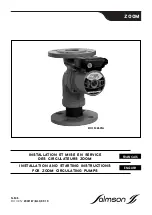
11
wire diameter. High deposition rates are
possible and weld appearance and reliability
are good. Most metals can be welded, but
the technique is limited generally to plate
thicknesses greater than 6mm. Spray transfer,
due to the tendency of the large weld pool to
spill over, cannot normally be used for positional
welding. The main exception is aluminium and
its alloys where, primarily because of its low
density and high thermal conductivity, spray
transfer in position can be carried out.
The current flows continuously because of the
high voltage maintaining a long arc and short-
circuiting cannot take place. It occurs best with
argon-based gases.
1
2
6
3
4
5
1
Gas shroud
4
Droplets
2
Wire
5
Weld
3
Shielding gas
6
Workpiece
Schematic of Spray Transfer
In solid wire MIG, as the current is increased,
dip transfer passes into spray transfer via a
transitional globular transfer mode. With metal-
cored wires there is virtually a direct transition
from dip transfer to spray transfer as the
current is increased.
For metal cored wire spray transfer occurs
as the current density increases and an arc is
formed at the end of the filler wire, producing
a stream of small metal droplets. Often the
outside sheath of the wire will melt first and
the powder in the centre flows as a stream of
smaller droplet into the weld pool. This effect
seems to give much better transfer of alloying
elements into the weld.
In spray transfer, as the current density
increases, an arc is formed at the end of the
filler wire, producing a stream of small metal
droplets. In solid wire MIG this transfer mode
occurs at higher currents. Flux-cored wires do
not achieve a completely true spray transfer
mode but a transfer mode that is almost true
spray may occur at higher currents and can
occur at relatively low currents depending on
the composition of the flux.
Rutile flux-cored wires will operate in this
almost-spray transfer mode, at all practicable
current levels. They are also able to operate
in this mode for positional welding too. Basic
flux-cored and self-shielded flux-cored wires do
not operate in anything approaching true spray
transfer mode.
Pulsed Transfer
Pulsed arc welding is a controlled method of
spray transfer, using currents lower than those
possible with the spray transfer technique,
thereby extending the applications of MIG
welding into the range of material thickness
where dip transfer is not entirely suitable.
The pulsed arc equipment effectively combines
two power sources into one integrated unit.
One side of the power source supplies a
background current which keeps the tip of the
wire molten. The other side produces pulses
of a higher current that detach and accelerate
the droplets of metal into the weld pool. The
transfer frequency of these droplets is regulated
primarily by the relationship between the two
currents. Pulsed arc welding occurs between
±50-220A, 23–35 arc volts and only with argon
and argon-based gases. It enables welding to be
carried out in all positions.
Содержание 180P
Страница 1: ...180P O P E R AT I N G M A N U A L...










































